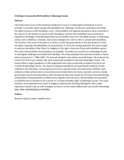| dc.description.abstract | There have been cases of discrimination
evidenced in access to meaningful participation
in many activities in societies where people with
disabilities live. Although, the Kenyan
constitution enshrined the rights of persons with
disabilities, socio- cultural beliefs and negative
perceptions have continued to be a barrier to the
freedom of persons with disabilities. Persons
with disabilities have continued to experience
challenges including being locked up and denied
access into the public domain. In Kakamega,
names such as lifokhoyo, lindonde, musiru and
shiyingwa are used to refer to people with disabilities. The Church as the voice of the state is to advice or assist the
government on the way forward on how the rights of people with disabilities can be protected. It’s from this
background that, this study sought to examine the ability of the Church to mitigate on the rights of persons living
with disabilities against the social cultural beliefs and perceptions on disability. The study was carried out in
Kakamega County to investigate challenges associated with disability. The study employed the social discrimination
theory whose proponent is T. Billet 2009. The research adopted a descriptive research design. The research was
carried out from 6 sub counties who were purposively sampled to represent Kakamega County. The research had a
target population of 264 respondents who were purposively sampled from the 6 sub counties in Kakamega County.
The research employed qualitative and quantitative methods of data collection. Oral interviews, Focused group
discussion, questionnaires and observation methods were utilized to collect primary data and secondary data
derived from text books, manuals, journals, articles, government records and newsletters which formed the
literature review for the study. Research findings revealed that misinterpretation of biblical texts together with the
socio-cultural beliefs and perception on disability have continued to be a barrier to a achieve disability rights in
Kakamega County. This study therefore recommended that a team of religious professionals including theologians
with a wide experience should come up with strategies on how to correct these biblical texts and provide knowledge
and a clear understanding on disability. | en_US |

